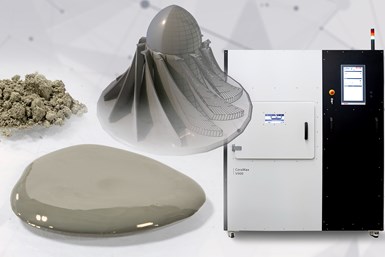Lithoz, ORNL Partner to Advance Processing for High-Temperature Ceramics
The new process could enable laser slurry drying of non-oxide ceramics with high refractive indexes
Share
The technical collaboration will focus on innovating high-temperature ceramics processing via the use of Lithoz 3D printing technology. Source: Lithoz
Lithoz and the U.S. Department of Energy’s (DOE) Oak Ridge National Laboratory (ORNL) have signed a Cooperative Research and Development Agreement (CRADA) to use Lithoz’s 3D printing technology to further explore the processing and additive manufacturing (AM) of non-oxide ceramics.
Based on laser-induced slipcasting (LIS) technology, the Lithoz 3D printer uses laser slurry drying (net shaping) technology to guide computer-controlled light amplification by stimulated emission of radiation that desiccates liquid-suspended controlled layers of solids. The goal of the cooperative agreement is the development of the technology to shape non-oxide ceramics with high-refractive indexes, such as silicon carbide, for use in extreme temperature applications. The new process could enable laser slurry drying of non-oxide ceramics with high refractive indexes
Lithoz launched its LIS technology to produce parts that are far more complex in geometry and larger in scale than can be achieved using conventional molding techniques. By incorporating intricate inner channels and 3D-printable complex designs, the parts it can produce are lighter and more efficient when compared with current methods. This technology is also capable of increasing the range of materials that can be printed by processing dark ceramics, such as silicon carbide and silicon nitride, in a way that is unachievable with other processes.
The goal of this project is to scale up the production of ultrahigh-temperature ceramic parts to an industrial level. The team will look to develop this technology by assessing its technical capabilities using a common oxide-ceramic material. This will involve printing and debinding the primary
material —– such as silicon nitride and silicon carbide, two highly in-demand substances for aerospace applications – from the moulded component. Using heat, the substance will be formed into a solid material in a process known as sintering. The performance and properties of the printed materials will then be tested.
“This project will build on ORNL’s years of research in developing and testing high-temperature materials and ceramics,” said Corson Cramer, Extreme Environment Materials Processing Group
staff scientist at ORNL. “By combining our expertise with Lithoz 3D printing capabilities, we have the potential to change the concept of high-temperature ceramics processing for heat exchange, aerospace and defense applications.”
Related Content
-
AM 101: NanoParticle Jetting (NPJ)
The proprietary process from XJet builds ceramic and metal parts using nanoparticle suspensions. Learn how NPJ works in this introductory article, part of our AM 101 series.
-
Safer Nuclear Energy: 3D Printed Silicon Carbide Fuel Forms
Binder jetting provides a way to create pure silicon carbide fuel structures that can withstand the harsh environment of a nuclear reactor and provide a strong barrier against the release of radionuclides.
-
RAPID + TCT 2022 Report: Advancing into the Next Season of Additive Manufacturing: AM Radio #18
Editors Stephanie Hendrixson, Peter Zelinski and Julia Hider share observations, insights and photos from the latest RAPID + TCT trade show.
















